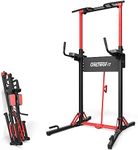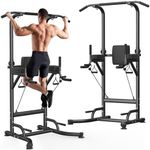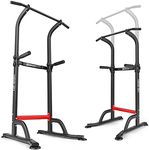Buying Guide for the Best Power Towers
When choosing a power tower, it's important to consider your fitness goals, available space, and the types of exercises you want to perform. Power towers are versatile pieces of equipment that allow you to perform a variety of bodyweight exercises, such as pull-ups, dips, and leg raises. Understanding the key specifications will help you select a power tower that best suits your needs and ensures a safe and effective workout experience.Stability and Build QualityStability and build quality are crucial for safety and performance. A power tower should be sturdy enough to support your weight and withstand vigorous use. Look for towers made from high-quality materials like steel, which provide durability and stability. The base should be wide and well-balanced to prevent tipping. If you're heavier or plan to use additional weights, opt for a tower with a higher weight capacity. Testing the tower's stability by gently shaking it can also give you an idea of its sturdiness.
Weight CapacityWeight capacity indicates the maximum weight the power tower can safely support. This is important to ensure the equipment can handle your body weight and any additional weight you might use during workouts. Power towers typically range from 200 to 400 pounds in weight capacity. Choose a tower with a capacity that exceeds your current weight to accommodate future weight gain or the use of weighted vests. If you're planning to share the equipment with others, consider the heaviest user when selecting the weight capacity.
Exercise StationsExercise stations refer to the different components of the power tower that allow for various exercises. Common stations include pull-up bars, dip bars, push-up handles, and vertical knee raise stations. The more stations a tower has, the more versatile your workouts can be. Consider your fitness goals and the exercises you plan to perform. If you want a full-body workout, look for a tower with multiple stations. If you have specific exercises in mind, ensure the tower includes those particular stations.
AdjustabilityAdjustability refers to the ability to modify the height or position of the exercise stations. This feature is important for accommodating different user heights and ensuring proper form during exercises. Some power towers offer adjustable pull-up bars or dip stations, which can be beneficial if multiple people of varying heights will use the equipment. If you're the sole user, ensure the tower's fixed positions suit your height and reach. Adjustability can enhance comfort and effectiveness in your workouts.
Footprint and Space RequirementsThe footprint of a power tower is the amount of floor space it occupies. This is important to consider, especially if you have limited space in your home or gym. Measure the area where you plan to place the tower and compare it to the dimensions of the tower. Some towers have a compact design, making them suitable for smaller spaces, while others require more room. Ensure you have enough space around the tower for safe and unrestricted movement during exercises.
Ease of AssemblyEase of assembly refers to how straightforward it is to put the power tower together. This is important if you plan to assemble the equipment yourself. Some towers come with detailed instructions and all necessary tools, making assembly easier. Others might require more time and effort. Consider your comfort level with assembling equipment and whether you have someone to assist you. Reading user reviews can provide insights into the assembly process and any potential challenges.

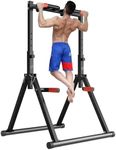
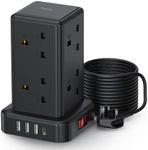
![Tower Extension Lead, [13A 3250W] S](https://images-proxy.bestreviews.guide/LUqsJkQKa-wcGJenA5M_nMZsLXw=/0x150/https://m.media-amazon.com/images/I/41xEQjKqvJL._AC_CX679_.jpg)
